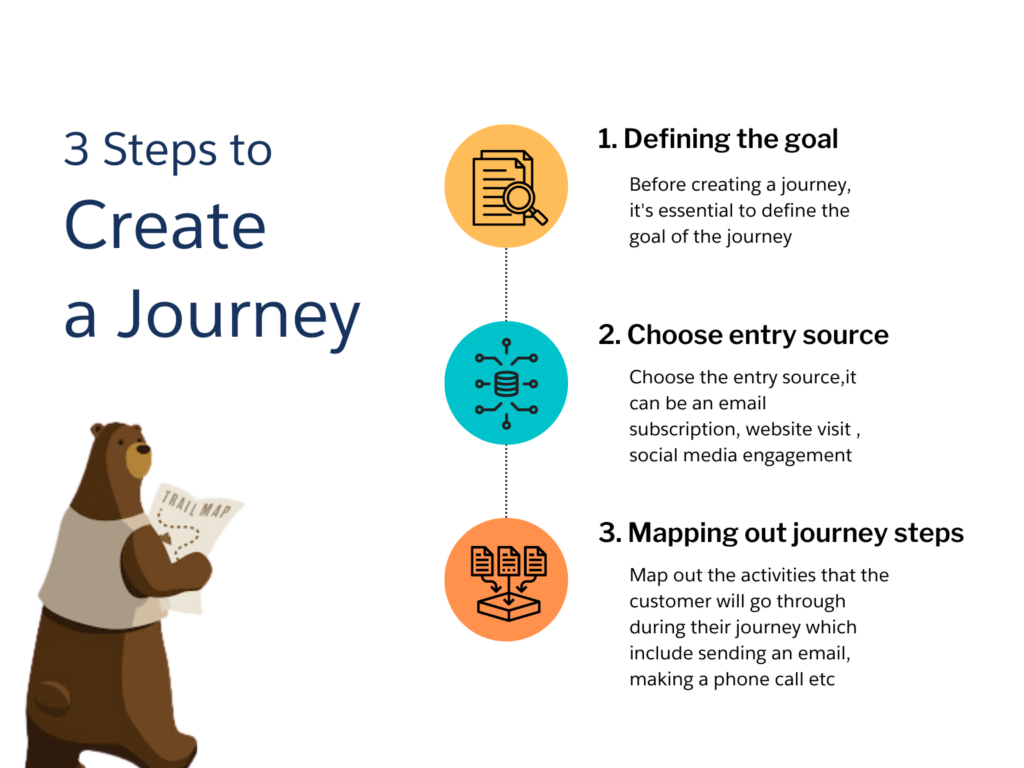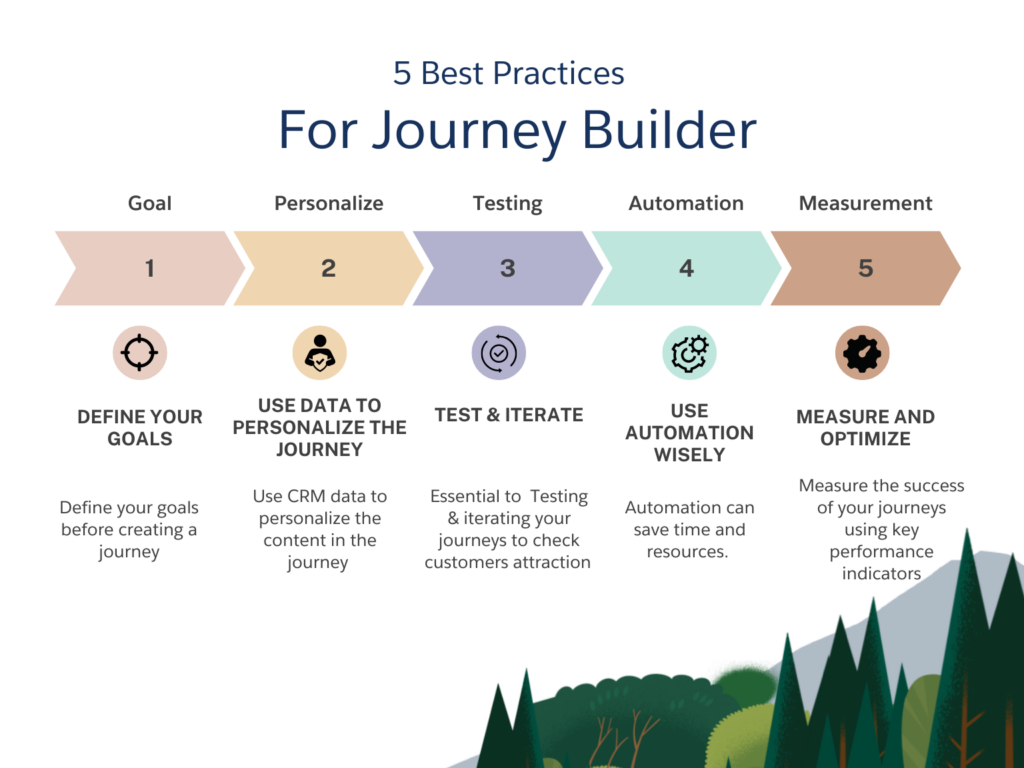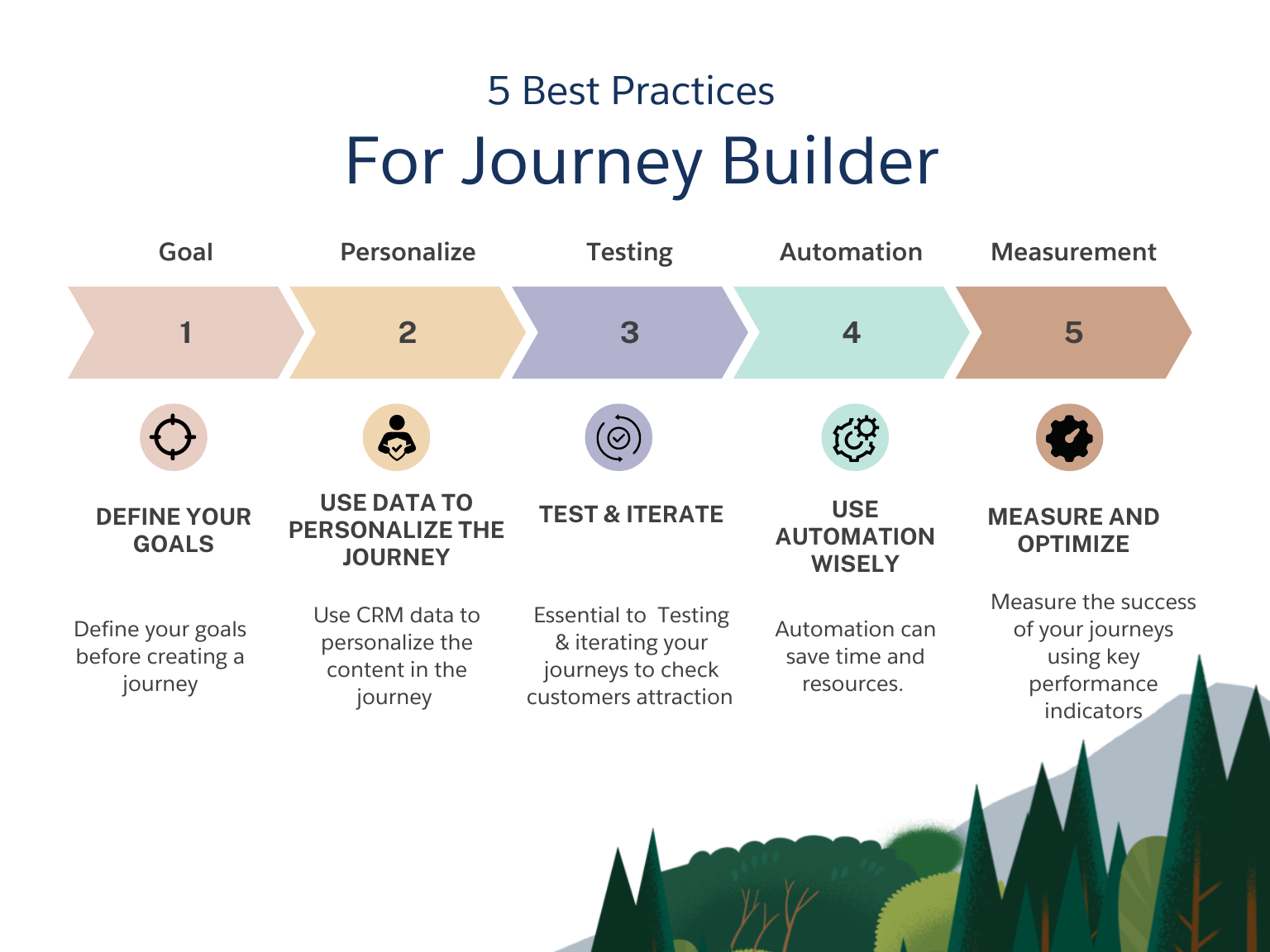Salesforce Journey Builder 101: A Beginner’s Guide to Customer Journeys
Introduction to Salesforce Journey Builder
Salesforce Journey Builder is a powerful tool that enables marketers to create and automate personalized customer journeys across multiple channels, such as email, mobile, social media, and more. With Journey Builder, you can map out the entire customer journey, from the moment a customer becomes aware of your brand to their post-purchase experience.
Journey Builder is part of Salesforce’s Marketing Cloud, which is a suite of tools designed to help marketers create, manage, and optimize their campaigns across multiple channels. With Journey Builder, you can create a seamless, personalized experience for your customers, which can help increase engagement, build loyalty, and drive revenue.
Benefits of using Journey Builder Some of the benefits of using Journey Builder include:
Improved customer experience: Journey Builder allows you to create personalized experiences for your customers, which can help increase engagement and build loyalty.
Greater efficiency: By automating your customer journeys, you can save time and resources, while still delivering a personalized experience.
Multichannel engagement: Journey Builder allows you to engage with customers across multiple channels, such as email, mobile, social media, and more.
Better insights: Journey Builder provides valuable data and insights into customer behavior, which can help you optimize your campaigns and improve your ROI.
Overall, Journey Builder is a powerful tool for marketers who want to create personalized, multichannel customer journeys that drive engagement, loyalty, and revenue.
Creating a Journey

Creating a journey in Salesforce Journey Builder is a straightforward process that involves defining the goal of the journey, choosing the entry source, and mapping out the journey steps.
Defining the goal of the journey
Before creating a journey, it’s essential to define the goal of the journey. The goal should align with your overall marketing objectives and focus on the customer’s needs. For example, a goal for a welcome journey could be to provide a positive first impression of your brand and encourage customers to make their first purchase.
Choosing the entry source
The next step is to choose the entry source, which is the trigger that starts the journey. Entry sources can be a variety of things, such as an email subscription, website visit, social media engagement, or purchase. You can also use a Salesforce object, such as a lead or contact, as an entry source.
Mapping out the journey steps
After defining the goal and entry source, it’s time to map out the journey steps. This involves creating a series of steps or activities that the customer will go through during their journey. These activities can include sending an email, making a phone call, sending a text message, or displaying an ad. You can also use decision splits to create branching paths in the journey based on customer behavior or data.
Once you have mapped out the journey steps, you can use Journey Builder’s drag-and-drop interface to create and edit the journey. You can also preview the journey to see how it will look from the customer’s perspective.
Overall, creating a journey in Salesforce Journey Builder is a simple process that involves defining the goal of the journey, choosing the entry source, and mapping out the journey steps. With Journey Builder’s intuitive interface and powerful automation capabilities, you can create a personalized, multichannel journey that engages and delights your customers.
Journey Builder Features
Salesforce Journey Builder comes with several features that make it a powerful tool for marketers looking to create personalized, multichannel customer journeys. Some of the key features of Journey Builder include:
Automation Studio Integration:
Journey Builder integrates seamlessly with Automation Studio, which is a tool that allows you to create and automate marketing tasks. This integration enables you to trigger journeys based on customer behavior or data and automate tasks like sending emails or updating customer records.
Custom Object Integration:
Journey Builder also integrates with custom objects in Salesforce, which enables you to create personalized journeys based on any data you have in Salesforce. For example, you can create a journey based on a customer’s job title, industry, or location.
Decision Split Activities:
Decision split activities allow you to create branching paths in your journey based on customer behavior or data. For example, you can create a decision split based on whether a customer opened an email or clicked a link in the email, and then create different paths based on their behavior.
Goals and Exit Criteria:
You can set goals and exit criteria for your journeys, which allows you to measure the success of your journeys and ensure that customers don’t receive irrelevant or duplicate communications.
Overall, Journey Builder’s features enable you to create personalized, multichannel journeys that are tailored to your customers’ needs and behaviors. The tool’s automation capabilities and seamless integration with Salesforce make it a powerful tool for marketers looking to streamline their marketing processes and deliver an exceptional customer experience.
Best Practices for Using Journey Builder

While Journey Builder is a powerful tool, there are several best practices to keep in mind to ensure that your journeys are effective and engaging for your customers. Some of these best practices include:
Define your goals
Before creating a journey, it’s essential to define your goals and align them with your overall marketing objectives. This will help you create a journey that is focused on delivering value to your customers and achieving your business goals.
Use data to personalize the journey
Personalization is key to creating engaging customer journeys. Use data from your CRM or other sources to personalize the content and messaging in your journey. This can include personalizing emails, landing pages, and other touchpoints in the journey.
Test and iterate
Testing and iterating your journeys is essential to ensure that they are effective and engaging for your customers. Test different messaging, channels, and offers to see what resonates with your audience and iterate based on the results.
Use automation wisely
Automation can save time and resources, but it’s important to use it wisely. Avoid over-automating your journeys and losing the personal touch. Use automation to streamline tasks and provide relevant and timely communications to your customers.
Measure and optimize
Measure the success of your journeys using key performance indicators (KPIs) such as open rates, click-through rates, and conversion rates. Use this data to optimize your journeys and improve their effectiveness over time.
Overall, by following these best practices, you can create engaging and effective customer journeys using Salesforce Journey Builder. By focusing on personalization, testing, and optimization, you can deliver an exceptional customer experience that drives engagement, loyalty, and revenue.
Integrating Journey Builder with other Salesforce Products
Salesforce Journey Builder can be integrated with other Salesforce products to enhance its capabilities and provide a more comprehensive view of customer data. Some of the Salesforce products that can be integrated with Journey Builder include:
Sales Cloud: Integrating Journey Builder with Sales Cloud enables you to create journeys based on customer sales data, such as products purchased, sales stage, or lead source. This can help you create personalized journeys for leads and customers that are tailored to their sales journey.
Service Cloud: Integrating Journey Builder with Service Cloud allows you to create journeys based on customer service data, such as cases created, service level agreements, or customer feedback. This can help you create personalized journeys for customers that are tailored to their service needs.
Marketing Cloud: Integrating Journey Builder with Marketing Cloud enables you to create more comprehensive and personalized journeys based on marketing data, such as email engagement, website behavior, or social media interactions. This can help you create journeys that are tailored to each customer’s marketing journey and provide a more holistic view of their interactions with your brand.
Commerce Cloud: Integrating Journey Builder with Commerce Cloud allows you to create journeys based on customer shopping behavior, such as products viewed, added to cart, or purchased. This can help you create personalized journeys that promote related products or encourage repeat purchases.
Overall, integrating Journey Builder with other Salesforce products can enhance its capabilities and provide a more comprehensive view of customer data. By leveraging data from across the Salesforce ecosystem, you can create more personalized and effective customer journeys that drive engagement, loyalty, and revenue.
Use Cases for Journey Builder
Salesforce Journey Builder can be used in a variety of ways to create engaging and personalized customer journeys. Some common use cases for Journey Builder include:
Welcome Journeys
Welcome journeys are a great way to make a positive first impression on new customers. By sending a series of welcome emails or other communications, you can introduce new customers to your brand and products and encourage them to make their first purchase.
Onboarding Journeys
Onboarding journeys are designed to help customers get the most out of your products or services. By sending a series of educational emails, tutorials, or other communications, you can help customers learn how to use your products effectively and reduce the risk of churn.
Abandoned Cart Journeys
Abandoned cart journeys are designed to recover lost sales by sending a series of reminders or incentives to customers who have abandoned their carts. By offering discounts, free shipping, or other incentives, you can encourage customers to complete their purchases and increase your revenue.
Win-Back Journeys
Win-back journeys are designed to re-engage lapsed customers who have not made a purchase in a while. By sending a series of targeted communications, you can remind customers of your brand and products and encourage them to make a purchase.
Cross-Sell/Up-Sell Journeys
Cross-sell/up-sell journeys are designed to increase the lifetime value of your customers by promoting related products or services. By sending targeted communications based on customer behavior or preferences, you can encourage customers to make additional purchases and increase your revenue.
Overall, Journey Builder can be used in a variety of ways to create engaging and effective customer journeys that drive engagement, loyalty, and revenue. By focusing on the customer’s needs and preferences, you can create journeys that provide value and build long-term relationships with your customers.
Conclusion
Salesforce Journey Builder is a powerful tool for creating personalized and engaging customer journeys that drive engagement, loyalty, and revenue. By leveraging customer data and preferences, Journey Builder enables you to create journeys that provide value at every touchpoint and build long-term relationships with your customers.
Whether you’re creating welcome journeys, onboarding journeys, abandoned cart journeys, win-back journeys, or cross-sell/up-sell journeys, Journey Builder can help you create journeys that are tailored to each customer’s needs and preferences. And by integrating Journey Builder with other Salesforce products, you can enhance its capabilities and provide a more comprehensive view of customer data.
Overall, Journey Builder is a versatile and effective tool for creating customer journeys that deliver results. By focusing on the customer’s needs and preferences and leveraging the power of the Salesforce platform, you can create journeys that drive engagement, loyalty, and revenue and build long-term relationships with your customers.

